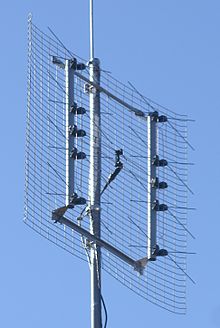
Back Matriu d'antenes Catalan آرایه آنتن FA Réseau d'antennes French ऐन्टेना व्यूह HI Անտենային ցանցեր HY Schiera di antenne Italian アレイアンテナ Japanese Антенналық тор KK Szyk antenowy Polish Антенная решётка Russian


An antenna array (or array antenna) is a set of multiple connected antennas which work together as a single antenna, to transmit or receive radio waves.[1]: p.149 [2] The individual antennas (called elements) are usually connected to a single receiver or transmitter by feedlines that feed the power to the elements in a specific phase relationship. The radio waves radiated by each individual antenna combine and superpose, adding together (interfering constructively) to enhance the power radiated in desired directions, and cancelling (interfering destructively) to reduce the power radiated in other directions. Similarly, when used for receiving, the separate radio frequency currents from the individual antennas combine in the receiver with the correct phase relationship to enhance signals received from the desired directions and cancel signals from undesired directions. More sophisticated array antennas may have multiple transmitter or receiver modules, each connected to a separate antenna element or group of elements.
An antenna array can achieve higher gain (directivity), that is a narrower beam of radio waves, than could be achieved by a single element. In general, the larger the number of individual antenna elements used, the higher the gain and the narrower the beam. Some antenna arrays (such as military phased array radars) are composed of thousands of individual antennas. Arrays can be used to achieve higher gain, to give path diversity (also called MIMO)[3] which increases communication reliability, to cancel interference from specific directions, to steer the radio beam electronically to point in different directions, and for radio direction finding (RDF).[4]
The term antenna array most commonly means a driven array consisting of multiple identical driven elements all connected to the receiver or transmitter. A parasitic array consists of a single driven element connected to the feedline, and other elements which are not, called parasitic elements. It is usually another name for a Yagi–Uda antenna.
A phased array usually means an electronically scanned array; a driven array antenna in which each individual element is connected to the transmitter or receiver through a phase shifter controlled by a computer. The beam of radio waves can be steered electronically to point instantly in any direction over a wide angle, without moving the antennas. However the term "phased array" is sometimes used to mean an ordinary array antenna.[4]
- ^ Carr, Joseph; Hippisley, George (2012). Practical Antenna Handbook, 5th Ed. McGraw-Hill. ISBN 9780071639590.
- ^ Graf, Rudolf F., ed. (1999). "Antenna". Modern Dictionary of Electronics. Newnes. p. 29. ISBN 978-0750698665. uah1PkxWeKYC.
- ^ Poole, Ian (2016). "What is MIMO? Multiple Input Multiple Output Tutorial". Antennas and propagation. Radio-electronics.com (Adrio Communications. Retrieved February 23, 2017.
- ^ a b Bevelacqua, Peter (2016). "Array Antennas". Antenna-theory.com. Retrieved February 23, 2017.